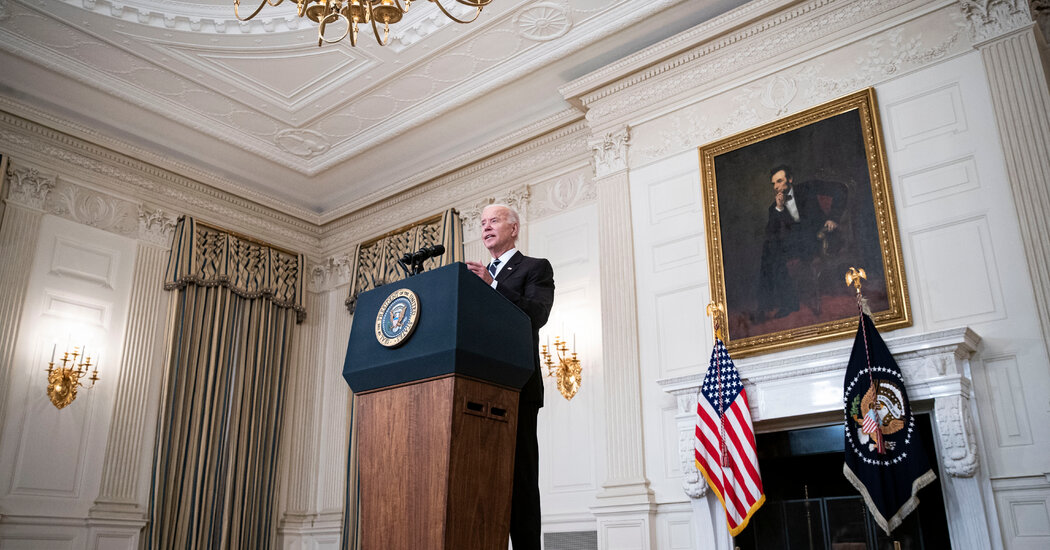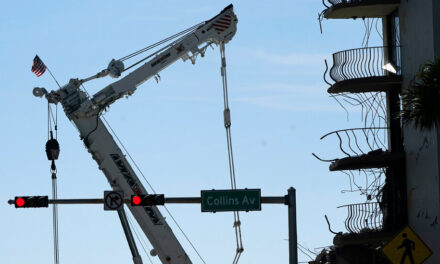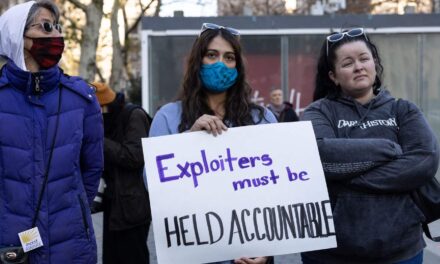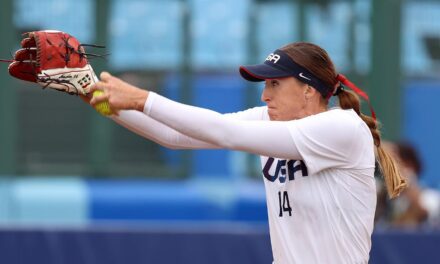
Republicans Attack President Biden’s Vaccine Mandates

Daily Covid Briefing
Sept. 11, 2021, 5:37 p.m. ET
Sept. 11, 2021, 5:37 p.m. ET

President Biden’s far-reaching assertion of presidential authority to require vaccines for 80 million American workers relies on a first-of-its-kind application of a 51-year-old law that grants the federal government the power to protect employees from “grave dangers” at the workplace.
White House officials believe the emergency authority provided by Congress under the Occupational Safety and Health Act of 1970 is a legitimate and legal way to combat the coronavirus pandemic. But they acknowledge that the law’s emergency provisions, which were employed in previous decades to protect workers from asbestos and other industrial dangers, have never been used to require a vaccine.
The novelty of the effort is at the heart of legal threats from Republican lawmakers, governors, pundits and others, many of whom have vowed to challenge the president’s use of the workplace rules. Gov. Brian Kemp, Republican of Georgia, said the move “is blatantly unlawful, and Georgia will not stand for it.” Senator Ted Cruz, Republican of Texas, called Mr. Biden’s actions “utterly lawless” on Twitter.
In a fund-raising email sent on Friday, Gov. Ron DeSantis of Florida, a Republican who has issued antimask orders, wrote, “Joe Biden has declared war on constitutional government, the rule of law, and the jobs and livelihoods of millions of Americans.”
But top aides to the president do not appear to be shaken by what they say was an expected response from those quarters. On Friday morning, Mr. Biden responded to threats of lawsuits from his adversaries.
“Have at it,” he said.
And experts said the administration appeared to be on strong legal ground because it was relying on existing authority granted to the Occupational Safety and Health Administration by the legislative branch and supported by decades of judicial rulings.

Japan initially struggled to get its Covid-19 vaccination program into full gear, but now that it has, the percentage of its population that has received at least one dose has edged past the level achieved in the United States — leaving Americans last for that category among the world’s seven wealthiest large democracies.
The turning point came on Thursday, when Our World in Data, a project by the University of Oxford in England, reported that 62.16 percent of Japanese people were at least partially vaccinated, compared to 61.94 percent of Americans.
For the moment, the United States retains a slightly larger percentage of fully vaccinated people than Japan, 52.76 percent compared to 50.04 percent, according to Our World in Data, ranking sixth out of the Group of 7 nations, after Britain, Canada, France, Germany, and Italy. But the United States appears all but certain to fall to last place among the Group of 7 nations shortly, given the rapid pace of achieving full vaccinations in Japan and the extremely slow rate in the United States.
Between July 24 and Sept. 9, the full vaccination rate in the United States grew by around 4 percent, while in the same period Japan lifted its level by 25 percent, a jump that doubled the size of its fully vaccinated population. Using doses made by Pfizer, Moderna and AstraZeneca, Japan is administering more than a million vaccine doses per day, some 300,000 above the U.S. average, even though the U.S. population is more than 2.6 times the size of Japan’s.
In Japan, new cases have fallen sharply from a peak of 23,083 on Aug. 25 to 11,347 on Friday, though Japan did confront a dramatic rise in new cases in July and August, coinciding with the Olympics. In the United States, cases spiked starting in early July.
Canada leads the G7 countries in vaccination rates, with almost three-quarters of its population at least partially vaccinated as of Thursday, according to Our World in Data. France, Italy and Britain follow, with percentages between 70 and 73. Germany’s rate is just ahead of Japan’s, at around 65 percent.
The U.S. vaccination curve has leveled dramatically since an initial surge in the first half of this year, when the vaccine first became widely available. In a push to vaccinate the roughly 80 million Americans who are eligible for shots but have not gotten them, President Biden on Thursday mandated that two-thirds of American workers, including health care workers and the vast majority of federal employees, be vaccinated against the coronavirus.
Open image modal at item 1 of 5
Open image modal at item 2 of 5
Open image modal at item 3 of 5
Open image modal at item 4 of 5
Open image modal at item 5 of 5
Wendy Lanski, 51, monitored the helicopters flying overhead as she stood by the Empty Sky Memorial inside Jersey City’s Liberty State Park on Saturday afternoon.
“To you it’s a helicopter, to me it’s suspicious,” she said. “If there is an unexpected loud noise, it doesn’t go away. The PTSD, the health effects, all of that.”
Ms. Lanski was a project manager for Empire Blue Cross Blue Shield on Sept. 11, 2001, and was preparing for a 9 a.m. meeting in her office on the 29th floor of the World Trade Center’s North Tower, when American Airlines Flight 11 crashed into her building. She felt the impact and fled down the stairs.
When she got to the lobby, she heard people shouting at her to run, cover her head and not look up. She saw people jumping and ran through the rubble of the collapsed tower before losing her shoes along the way. She reached the Hudson River and escaped via the New York Waterway Ferry to New Jersey.
On Saturday, she met Armand Pohan, the ferry’s chairman and C.E.O., before a remembrance ceremony that featured Gov. Philip Murphy and Senators Robert Menendez and Cory Booker of New Jersey. Ms. Lanski, who has “9/11/01” and “survivor” tattooed above her right ankle, credited the ferry with saving her life two decades ago.
“I burst into tears,” she said of her meeting with Mr. Pohan. “It was full circle.”
Image
Ms. Lanski, who lives in West Orange, N.J., is a secretary on the board of directors for the New Jersey 9/11 Memorial Foundation and works for Horizon Blue Cross Blue Shield. In March 2020, she was diagnosed with Covid-19, and she had to breathe through an oxygen mask while hospitalized.
When she beat the virus, Mr. Murphy called her, and before he took the stage on Saturday, she reintroduced herself and shook his hand.
“It just keeps coming,” she said. “If Osama bin Laden didn’t kill me, I’m not dying from a virus. You just keep going. Just because you had a tragedy, it doesn’t stop you from having others.”
— Kevin Armstrong

Despite the sudden loss of 20 million jobs at the start of the coronavirus pandemic, food insecurity among Americans remained unchanged last year, the government reported on Wednesday, in what researchers called a testament to a vast expansion of government aid.
As lines outside food banks stretched for miles in March 2020, experts feared a hunger crisis was looming, but billions in emergency aid forestalled the expected rise in hunger, keeping levels of hardship flat.
“This is huge news — it shows you how much of a buffer we had from an expanded safety net,” said Elaine Waxman, who researches hunger at the Urban Institute in Washington. “There was no scenario in March of 2020 where I thought food insecurity would stay flat for the year. The fact that it did is extraordinary.”
The government found that 10.5 percent of American households were food insecure, meaning that at some point in the year they lacked the money to provide enough food to the family. It also found that 3.9 percent had “very low food insecurity,” meaning the lack of resources caused a reduction in food intake, a number statistically unchanged from the previous year.
Food insecurity did rise among families with children, Black Americans, and households in the South. The already-large gap between Black and white households widened further, with 21.7 percent of Black households experiencing food insecurity, compared with 7.1 percent of white households. That 14.6-percentage point gap is up from 11.2 points in 2019.
Black households suffered disproportionately from pandemic-era job loss and had fewer assets with which to buffer a crisis. Still, the overall pattern of constraining the effects on hunger contrasted sharply with the country’s experience when nearly 13 million more Americans became food insecure during 2008, when the Great Recession occurred. Last year, 38.3 million people were food insecure, far fewer than the 50.2 million at the Great Recession’s peak.
With President Biden pushing a $3.5 trillion legislative program that would further expand the safety net, the report on Wednesday from the Agriculture Department provided fodder for both sides. Supporters say it shows the value of expanded government spending, while critics say the food hardship figures show further spending is not necessary.
The expansions occurred early in the pandemic, but subsequent aid followed, most recently in a $1.9 trillion spending package in March that among other things, offered monthly cash payments to nearly all families with children.

President Biden’s new coronavirus vaccination mandates have prompted some backlash, but the two federal departments that already require vaccinations say their actions are doing what they intended: getting more shots in arms.
Since the Pentagon announced last month that active-duty military personnel would be required to be vaccinated, the percentage of service members with at least one shot has risen to 83 percent from 76 percent, according to Defense Department data.
At the Department of Veterans Affairs, which issued a vaccine mandate for its 115,000 frontline health care workers seven weeks ago, 82 percent of those employees are now fully vaccinated, up from 77 percent, and the number of shots it has given to all of its workers has more than doubled since early July, said Terrence Hayes, a spokesman for the department.
The increases elude the goals of getting virtually everyone at both agencies inoculated, but at least in the military, where troops have long been used to taking orders and avoiding voluntary actions, the numbers are expected to rise. Each service branch is working through its enforcement plan.
Military leaders had grown tired of vaccination rates that stagnated for months. The low rates were threatening troop readiness, commanders said, and flew in the face of the many vaccine mandates troops must already accept.
But the military in this case reflects the broader culture. More than 80 percent of active-duty service members are under 35, a group that often views itself as impervious to coronavirus infections. Many worry that the vaccines are unsafe, were developed too quickly or will affect fertility, and they have read the same conspiracy theories that have led other Americans to hesitate.

As schools resume in-person classes across the United States, many parents have grown increasingly anxious for their children under 12, who remain ineligible for Covid vaccinations. And so some of those parents are taking extraordinary steps to get their younger children vaccinated in one available channel: enrolling them in clinical trials.
Dr. Tina Sosa, a pediatric hospitalist and mother of two, was able to get her 3-year-old son vaccinated by enrolling him in a Pfizer trial at Cincinnati Children’s Hospital Medical Center during her fellowship there. He had no side effects from the two shots he received in April, she said. “I even squeezed his arm and asked did it hurt, and he said no.”
Now at the University of Rochester Medical Center in upstate New York, Dr. Sosa enrolled her 7-month-old in a Moderna trial set to there begin next month.
Another parent, Leng Vong Reiff of Clive, Iowa, jumped when she heard of openings in a Pfizer trial taking place hours away at a Nebraska clinic.
But spots in clinical trials are relatively rare, and it will be months before the F.D.A. can fully assess the results and decide whether lowering the age of eligibility is warranted — so some parents have even sought, through their pediatricians, off-label shots that are adult doses, a practice the F.D.A. discouraged on Friday.
This summer has been particularly trying for parents, especially after public health experts warned that the Delta variant was highly transmissible — even from vaccinated household members. Although children still are less likely than adults to be hospitalized or die from Covid, nearly 30,000 children with Covid were admitted to hospitals in August, the highest level to date.
As many as 48 million U.S. children are under 12, and Covid concerns about them extend beyond their immediate health. They form a sizable pocket of vulnerability for the nation, one that will remain even if President Biden succeeds in vaccinating 80 million people or more under the mandates he announced on Thursday.
— Deborah Schoch

On Thursday, in a wide-ranging speech outlining aggressive steps to curb the spread of the coronavirus, President Biden announced that the Transportation Security Administration would double fines for travelers who refuse to wear masks in airports and on commercial airplanes.
“If you break the rules, be prepared to pay — and by the way, show some respect,” Mr. Biden said, referencing the change in policy as well as the many incidents in recent months of rude passengers who refused to mask up on domestic flights.
As of Friday, penalties for first-time offenders have been raised to a minimum of $500. Second-time mask refusers may be fined as much as $3,000.
Many flight attendants and travelers responded enthusiastically online to the declaration. But the announcement also raised a critical question: How will enforcement of these fines work?
Since February, when the T.S.A. first announced a requirement that everyone — except children under 2 and people with some disabilities — wear masks on airplanes and in airports in the United States, the agency has received more than 4,000 reports of mask related incidents, according to R. Carter Langston, a T.S.A. spokesman.
However, only 126 people have faced fines, he said.

Denmark has lifted the last of its coronavirus restrictions, effectively declaring that the virus was no longer a “critical threat to society” and allowing the country to get back to a semblance of prepandemic normal.
“This can only be done because we have come a long way with the vaccination rollout, have a strong epidemic control, and because the entire Danish population has made an enormous effort to get here,” Magnus Heunicke, Denmark’s health minister, said in a statement on Friday about the lifting of restrictions.
The Danish government announced late last month that it would allow the restrictions to lapse, and pointed to Denmark’s high vaccination rates. As of Saturday, about 76 percent of the country’s population had received one dose of a vaccine, and 73 percent had been fully vaccinated, according to data compiled by The New York Times.
While the rules lifted on Friday allow Danes to go more freely about their lives, foreign travelers will still be subject to some restrictions, including presenting a negative coronavirus test upon arrival or possibly even isolating for 10 days, depending on where they are coming from.
The Danish government had been gradually easing its coronavirus restrictions for weeks, including lifting a public transportation mask mandate in mid-August. But the rules lifted this week included the expiration of the coronavirus passport requirement that it had in place for entry into venues like nightclubs.
Mr. Heunicke said that the Danish government would continue to monitor the pandemic, and that it would be “ready to act quickly” if the situation were to deteriorate.
Denmark was one of the hardest hit countries of Scandinavia, though its northern neighbor Sweden, which shunned hard lockdowns, fared far worse. But cases have fallen in both, and Sweden expects to loosen most of its restrictions starting at the end of the month.
By contrast, Norway, which like Finland had kept cases low through most of the pandemic, is experiencing is worst outbreak to date. However, deaths remain low thanks to Norway’s high vaccination rates — 74 percent of the population have had at least one shot and 64 percent are fully vaccinated.
Source: https://www.nytimes.com/live/2021/09/11/world/covid-delta-variant-vaccine/

















